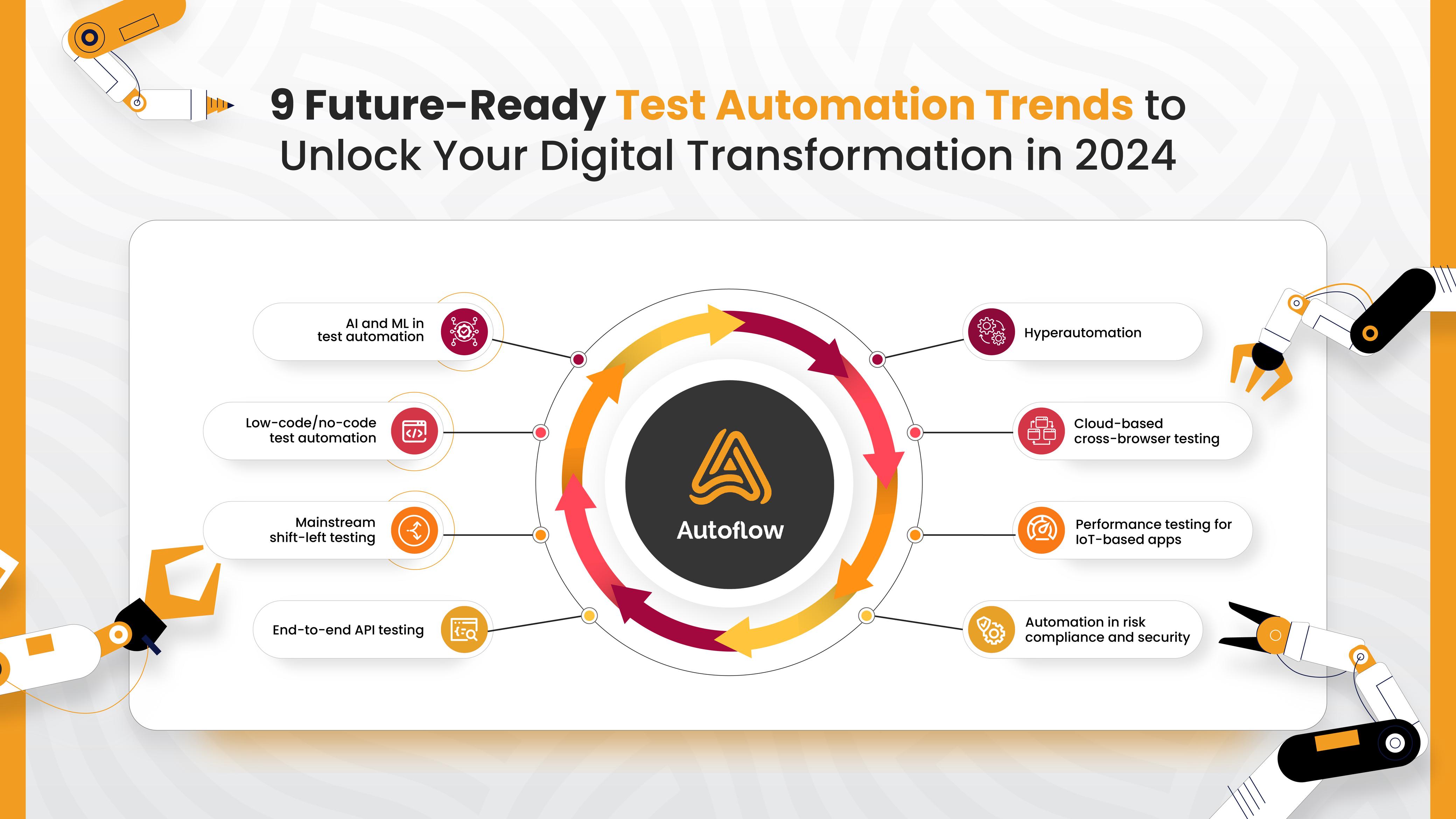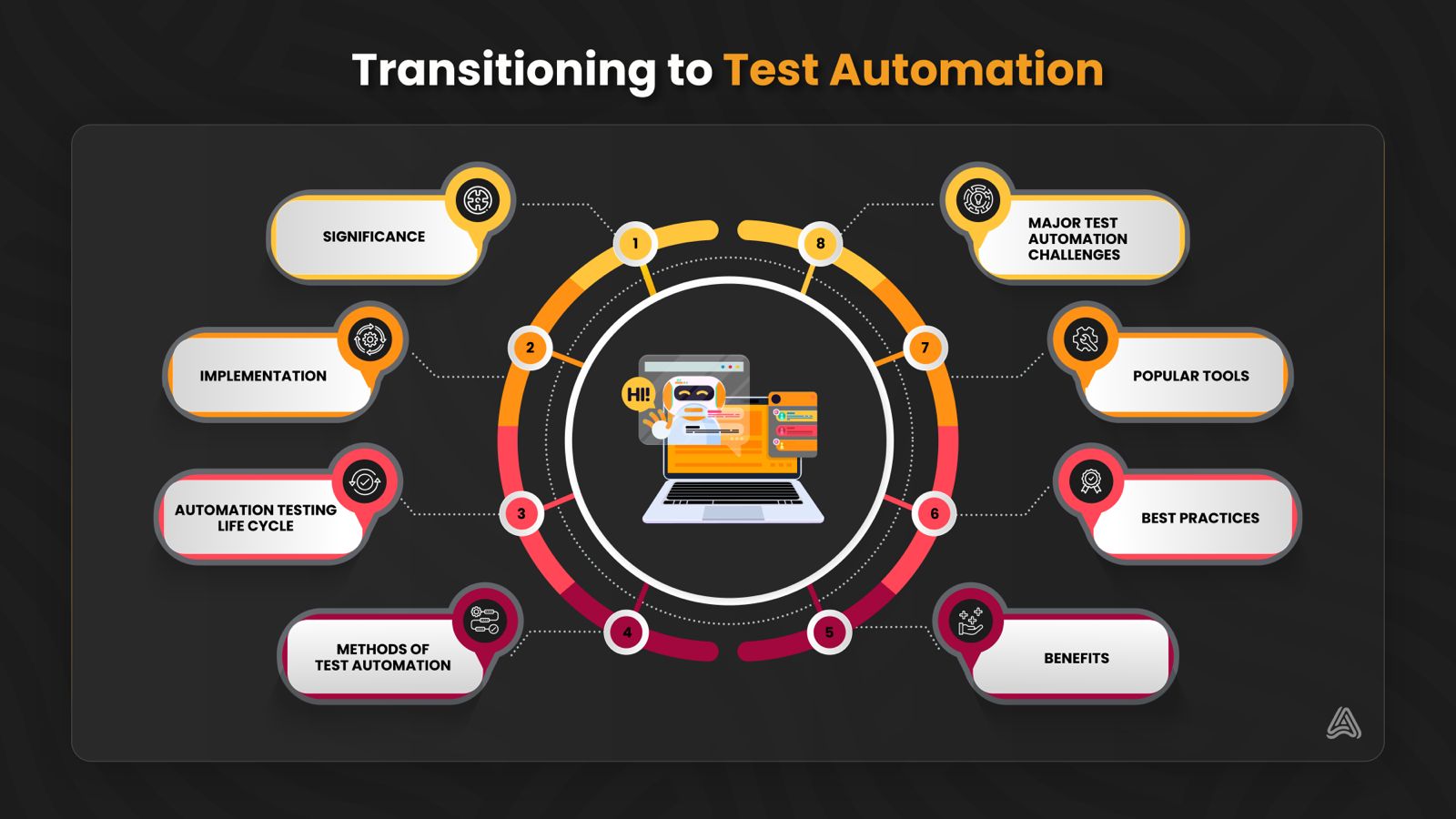7 min to read
9 Future-Ready Test Automation Trends to Unlock Your Digital Transformation in 2024

 Introduction
Introduction
“The first rule of any technology used in a business is that automation applied to an efficient operation will magnify the efficiency. The second is that automation applied to an inefficient operation will magnify the inefficiency. ”
- Bill Gates
This quote resonates with the riveting nature of automation in any operation and how it is vital in driving an organization’s digital transformation. Test automation is one such technology that has become indispensable for any software development life cycle. This technology has evolved leaps and bounds from bug identifications to enabling QA teams to work proactively towards developing superior products with diverse functionalities.
With a 16% Compound Annual Growth Rate (CAGR), the test automation market is estimated to be worth $32 billion in 2024 and is expected to surpass the $70 billion mark by 2029*.
(Source: https://www.mordorintelligence.com/industry-reports/automation-testing-market)*
This growth presents an excellent opportunity for organizations to improve their test automation capabilities and operational efficiency. Thus, staying in touch with the latest industry trends that can revolutionize the test automation sector is non-negotiable. Let’s delve deeper into the major 2024 trends that will help you embrace the future of test automation.
 AI and ML in test automation
AI and ML in test automation
One of the most highlighted test automation trends in 2024 is the scope of artificial intelligence (AI) and machine learning (ML) in test automation. AI and ML can help enhance your test efficiency through powerful algorithms that can analyze user stories, application changes, and requirements to develop optimal test cases.
AI/ML techniques like generative adversarial networks (GANs) can generate production-grade data sets with more extensive test coverage. This technique also helps you mitigate the challenges of generating qualitative large-scale test data.
AI models can facilitate automated root cause analysis by analyzing the logged telemetry across the integrated architecture. These models can swiftly and automatically diagnose the possible root causes of software failures.
A few notable examples are tools like AutoFlow Studio, Testsigma, and BrowserStack, which leverage AI to enhance test automation capabilities while offering features like visual testing and intelligent test case generation.
 Low-code/no-code test automation
Low-code/no-code test automation
According to multiple surveys, by 2025, about 70% of newly built applications will incorporate codeless test automation. As low-code or no-code development adoption rises, the demand for test automation solutions customized for low-code platforms will spike. Codeless development platforms can delegate faster app delivery with nominal hand-coding.
Low-code apps support web, mobile, and other channels requiring end-to-end testing automation across platforms. However, connecting low-code apps to existing systems requires API and integration testing. As the adoption of large portfolios of codeless apps increases across enterprises, the testing capabilities must economically scale.
AutoFlow Studio, Katalon Studio, and TestComplete offer no-code/low-code automation capabilities that enable faster adoption of test automation practices.
 Mainstream shift-left testing
Mainstream shift-left testing
Another key 2024 test automation trend is the increasing momentum of shift-left testing. This process necessitates early test automation executions against code revisions in the software delivery life cycle instead of only pre-production. You can enable shift-left testing using continuous integration and delivery (CI/CD) pipeline integration to recognize defects in your code faster.
Testing techniques such as performance testing, unit testing, and integration testing are among the first to shift left. DevOps teams must prioritize shift-left testing in the software lifecycle to execute faster against CI/CD pipeline code changes.
CI/CD tools like Jenkins, GitLab, and CircleCI allow shift-left testing by integrating automated tests into the build process, ensuring continuous quality checks. Test automation frameworks like AutoFlow Studio, Selenium, Appium, and JUnit allow teams to automate web applications and API testing.
 End-to-end API testing
End-to-end API testing
As the name suggests, end-to-end testing covers complete application flows from beginning to end. Each flow indicates a user’s sequence of actions in the application and may include multiple endpoints and APIs. End-to-end testing can help you recognize roadblocks, integration errors, and problems concerning user experience.
End-to-end testing ascertains that APIs perform as expected under different conditions and appropriately interact with system attributes like databases, external APIs, and applications. It simulates a real-world user scenario that mimics a production environment to ensure proper system functionality.
Well-known API testing platforms and tools like Karate, Postman, Parasoft, and Tricentis offer test automation capabilities, such as auto-generated test cases. However, cutting-edge solutions like AutoFlow Studio, Cypress, and Playwright will boost the adoption of end-to-end API testing.
 Hyperautomation
Hyperautomation
According to Gartner, hyperautomation is a business-driven, disciplined approach organizations use to rapidly identify, vet, and automate as many business and IT processes as possible. It involves the organized use of several technologies and platforms, such as AI, ML, event-driven software architecture, robotic process automation (RPA), natural language processing (NLP), and business process management (BPM). In addition, it also leverages integration platform as a service (iPaaS), intelligent business process management suites (iBPMS), low-code/no-code tools, packaged software, and other types of decision, process, and task automation tools.
Unlike automation, hyperautomation testing focuses on automating test dependencies and requirements like test data, test environment, test window, and the application. With multiple technologies in play, hyperautomation facilitates higher agility and flexibility in operations.
Adopting hyperautomation can help enterprises reduce manual intervention and costs via better process efficiency and intelligence while improving employee engagement and satisfaction. Furthermore, it can enable data democratization and greater collaboration to help unify processes and operations across teams and departments.
 Cloud-based cross-browser testing
Cloud-based cross-browser testing
With the mobile-first approach a priority for customers, organizations emphasize making an application more responsive on mobile devices. With millions of devices in the market with different browsers and screen resolutions, setting up a vast test automation infrastructure is cost-intensive. Hence, more companies have started adopting cloud-based cross-browser testing platforms.
These testing tools offer savings on infrastructure setup and maintenance costs, better availability and built-in collaboration, greater scalability, and seamless data backup and recovery.
While giants like Playwright and Puppeteer offer stellar cross-browser automation capabilities, new-age frameworks like AutoFlow Studio, Sauce Labs, and TestGrid extend comprehensive cloud-based testing prowess.
 Performance testing for IoT-based apps
Performance testing for IoT-based apps
According to a survey by Statista, IoT-enabled devices worldwide are estimated to reach 31 billion units by 2025. Organizations and developers will focus on the product’s performance testing as more users purchase smart, interconnected devices. Hence, you can witness a rise in the usage of simulator tools such as MATLAB, Simulink, IoTIFY, etc. These tools ease developers’ lives by simulating real-time prototypes, validating app optimization, and assessing their readiness to handle multiple devices and commands.
 Automation in risk compliance and security segments
Automation in risk compliance and security segments
Data security and compliance concerns are massive aspects you must factor in while developing a new product. Government and regulatory bodies are more vigilant about restricting enterprises’ use of customer data, and compliance with global data privacy regulatory bodies like ISO, GDPR, PCI DSS, etc., is stricter than ever before.
Test automation management tools like Datprof or EMS Data Generator can aid you with data masking or synthetic test data generation. The data generated with these tools simulates actual user data and can help you test while adhering to privacy laws. On the other hand, the onus rests on you to train your employees, conduct security audits, and impart data compliance training to prevent breaches or hacks.
 Quantum computing
Quantum computing
With the widespread use of quantum computing, QAs have their work cut out in ensuring that applications are secure and quantum-resistant. This emerging trend denotes a unique microniche in QA that demands advanced knowledge and specialized expertise. Quantum computing’s computational capabilities aim to bolster the AI competence of the BFSI industry for fraud detection, risk management, and high-frequency trading.
 Conclusion
Conclusion
The scope of test automation is ever-evolving, propelled by disruptive technologies, methodologies, and tools. We are seeing massive transitions towards scriptless and codeless testing, increased adoption of TDD and BDD, and emphasis on enhancing the user experience. As software becomes more complex, incorporating AI, ML, blockchain, and RPA will likely become more widespread.
Looking for a test automation tool to expedite your transition to becoming future-ready? AutoFlow Studio is one such test automation platform that can become your launchpad, accelerating your readiness to embrace these trends. Switch to AutoFlow Studio and learn how its extensive feature set can help you future-proof your test automation requirements. Sign up for a 30-day free trial to get started.


Comments